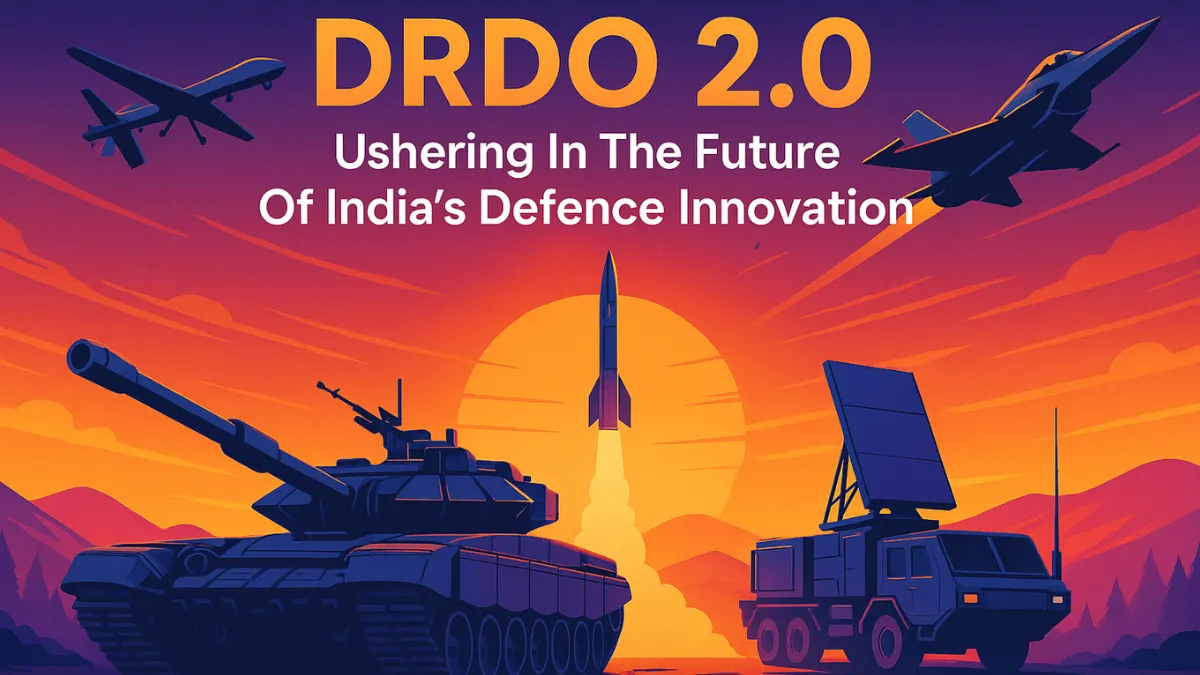DRDO 2.0 marks a transformative chapter in India’s defence research and development ecosystem. The Defence Research and Development Organisation (DRDO), long known for delivering core military systems such as missiles, radars, tanks, and electronic warfare equipment, is now shifting its strategic vision. This new era—dubbed DRDO 2.0—is focused on harnessing next-generation technologies and fostering deep collaboration with academia, startups, and the private sector to stay ahead of global military trends.
A Bold New Vision
The concept of DRDO 2.0 arises from a need to transition from being a manufacturer of conventional defence systems to becoming a futuristic technology enabler. As global warfare trends shift towards non-contact combat, cyber and electronic warfare, and precision-based deterrence, India’s defence establishment recognizes the importance of adopting cutting-edge fields like artificial intelligence (AI), machine learning, quantum computing, directed-energy weapons, space-based systems, and hypersonic technologies.
DRDO 2.0 is not just a branding exercise—it represents a radical rethinking of how defence research is organized, prioritized, and executed. The goal is to act as a catalyst for disruptive innovation while empowering India’s industrial base to take charge of mass production and iterative product development.
Redirecting Focus: From Production to Disruption
Under DRDO 2.0, the organization has made a clear decision to delegate conventional defence production and incremental system improvements to the private sector and public sector undertakings. This delegation allows DRDO to reallocate its resources and top talent towards high-risk, high-reward projects. The emphasis is now on disruptive technologies that require deep research and longer gestation periods—technologies that can define the battlespace of the next 20 to 30 years.
Key priority areas include:
- Hypersonic propulsion and glide systems
- Directed-energy weapons (DEWs), including high-powered lasers
- Quantum technologies for communication, encryption, and radar
- Artificial Intelligence (AI) for autonomous systems and situational awareness
- Smart materials and nano-technology for lightweight, adaptive armour
- High-performance computing and software-defined systems
These areas are no longer the luxury of future planning—they are the current necessity in a rapidly evolving geopolitical environment.
Industry-Academia Synergy
A major pillar of DRDO 2.0 is the strengthening of collaboration with academic institutions and private innovators. The creation and expansion of the Defence Industry-Academia Centres of Excellence (DIA-CoEs) is central to this. These Centres, set up in premier institutes like the IITs and IISc, focus on foundational research in critical verticals such as photonics, compound semiconductors, encryption systems, high-energy materials, and advanced sensor design.
DRDO 2.0 empowers young researchers, doctoral students, and postdoctoral fellows to work directly on classified defence projects, a move that was rare in previous models. This not only democratizes innovation but creates a national pipeline of defence-minded technologists and thinkers.
Moreover, the introduction of Young Scientist Laboratories (YSLs) allows researchers below the age of 35 to take charge of small, autonomous units that work on niche futuristic projects with minimal bureaucratic hurdles.
Role of Startups and MSMEs
With the launch of the Technology Development Fund (TDF), DRDO is actively incentivizing private sector participation—especially from startups and MSMEs. These firms are encouraged to co-develop prototypes, manufacture components, and experiment with unconventional materials and algorithms. Under DRDO 2.0, the idea is to create a robust supply chain where innovation can be quickly tested, refined, and scaled for deployment.
The policy environment has also shifted. DRDO now releases more of its patents to the public domain and shares non-sensitive technical documentation to fast-track industry participation. In this open innovation model, the government is a facilitator, not just a funder.
Internal Reforms and Organizational Agility
Internally, DRDO 2.0 is bringing about major reforms. Project timelines are being tightened, milestone-based evaluations are introduced, and redundancy in overlapping labs is being reduced. Performance metrics are now more aligned with mission outcomes than with process compliance.
Multidisciplinary project teams, consisting of experts in AI, avionics, materials, and electronics, are replacing traditional linear hierarchies. This matrix-style organization fosters faster decision-making, cross-pollination of ideas, and timely course correction—critical in high-tech R&D.
Moreover, DRDO is actively working on a system to declassify older projects, enabling legacy technologies to be transferred to academia or the public domain for further advancement.
Global Relevance and Strategic Autonomy
With DRDO 2.0, India aims to not just reduce import dependency but also to emerge as a global exporter of cutting-edge defence technology. By investing in technologies that are scarce globally—such as hypersonics, anti-satellite systems, and AI-powered battlefield analytics—India positions itself as a strategic player in global defence partnerships.
Strategic autonomy is the cornerstone. India does not seek to merely replicate existing systems but to lead in select technological domains. By staying ahead in research and innovation, DRDO ensures that India retains its freedom to operate, adapt, and respond across any domain—land, sea, air, cyber, or space.
The Road Ahead
The path to DRDO 2.0 is challenging, requiring sustained funding, continuous innovation, skilled manpower, and robust institutional frameworks. However, the momentum is already building. DRDO’s new mandate has already yielded visible outcomes in hypersonic testing, drone development, and directed-energy systems.
As India moves towards becoming a $10 trillion economy in the coming decades, national security will hinge not just on manpower or equipment numbers, but on technological superiority. DRDO 2.0 is India’s bold commitment to this future—a future where the country does not merely consume security solutions but creates them.
In this pursuit, DRDO 2.0 is not just a shift in policy—it is a revolution in thought.








